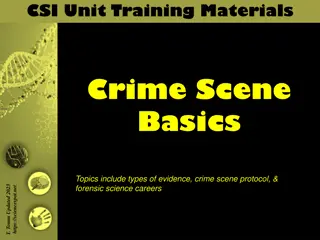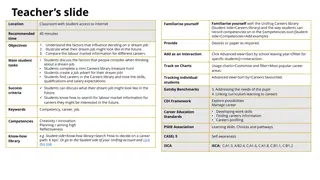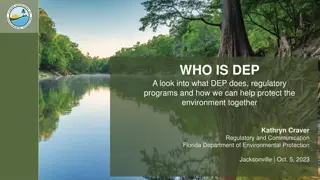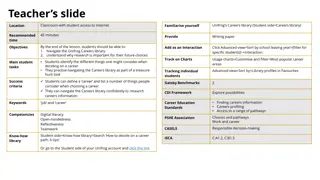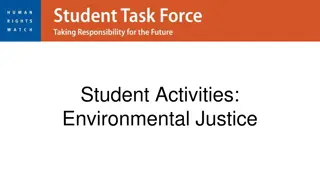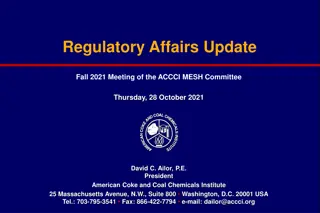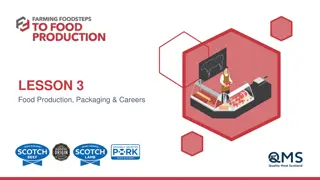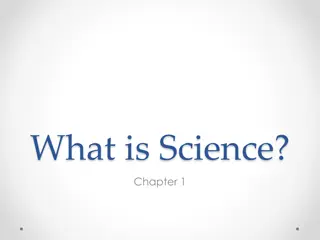Careers in Environmental Science Industry
Explore various career opportunities within the environmental science industry, including roles in water resources, soils, wildlife, and forestry. Learn about job responsibilities and required qualifications for positions such as soil conservationist, silviculturist, urban forester, wildlife biologist, and more.
Download Presentation

Please find below an Image/Link to download the presentation.
The content on the website is provided AS IS for your information and personal use only. It may not be sold, licensed, or shared on other websites without obtaining consent from the author. Download presentation by click this link. If you encounter any issues during the download, it is possible that the publisher has removed the file from their server.
E N D
Presentation Transcript
ENVIRONMENTAL SCIENCE Essential Standard 5.00: Understand the environmental science industry (water, soils, wildlife and forestry).
OBJECTIVE 5.01 Remember careers in the environmental science industry.
MAJOR CAREER AREAS OF ENVIRONMENTAL SCIENCE Water resources an essential nutrient for all plant and animal life Soil resources the top layer of the Earth s surface, which is suitable for the growth of plant life
MAJOR CAREER AREAS OF ENVIRONMENTAL SCIENCE Wildlife animals that are adapted to live in a natural environment without the help of humans Forestry industry that grows, manages, and harvests trees for lumber, posts, panels, paper and many other commodities
EXAMPLES OF CAREERS IN ENVIRONMENTAL SCIENCE Soil conservationist assists landowners in implementing best land use practices Soil scientist classify soil according to the most appropriate use. Requires bachelor s degree (4 yr) Silviculturist one who scientifically manages forests (specializing in the care of trees) Forestry consultant advises private forest land owners. Loggers one who harvests trees
EXAMPLES OF CAREERS IN ENVIRONMENTAL SCIENCE Urban Forester the one responsible for the health and well-being of our cities trees Wildlife biologist does research on habitat and wildlife and advises government agencies in establishing fish/game laws and habitat improvement programs. Requires minimum of bachelor s degree (4 yr) Wildlife manager often work in government agencies , advising land owners and managing game populations on public lands Wildlife officer/Game warden works for the agency (North Carolina Wildlife Commission) responsible for controlling the harvest of wildlife
EXAMPLES OF CAREERS IN ENVIRONMENTAL SCIENCE Soil technician uses soil auger/soil tube to take soil samples and do technical field work Wildlife technician works in the field tagging animals, gathering data and assisting with research Ecologists studies the effects of the environment on animal life
EXAMPLES OF CAREERS IN ENVIRONMENTAL SCIENCE Forester provides assistance in managing forests for the private landowner as well as the commercial grower Timber Cruiser are hired by private landowners and companies to estimate tree volume on a tract of land Logging foreman is responsible for overseeing and managing logging operations Skidder operators move felled trees form the cutting site to the loading area
OBJECTIVE 5.02 Understand biotechnology in the environmental science industry.
ENVIRONMENTAL BIOTECHNOLOGY Biotechnology is playing a large part in detecting and monitoring pollution and determining how much is present
ENVIRONMENTAL BIOTECHNOLOGY EXAMPLES Indicator species Lichens are widely used as environmental indicators or bio-indicators If air is very badly polluted with sulfur dioxide, there may be no lichens present, just green algae may be found
ENVIRONMENTAL BIOTECHNOLOGY EXAMPLES Bioremediation Bacteria is used to clean up oil and fuel spills Oleophilic (attracted to oil) bacteria used to clean up oil spills Hanahan, SC, a suburb of Charleston, had an 80,000 gallon jet fuel leak from a military fuel storage facility fuel entered the ground and the groundwater Bacteria were successfully used to remediate this problem
ENVIRONMENTAL BIOTECHNOLOGY EXAMPLES Biostimulation The Exxon Valdez clean-up Used the addition of nutrients Feed the oleophilic bacteria
ENVIRONMENTAL BIOTECHNOLOGY EXAMPLES Biodiesel made from oilseeds Soybean canola oil proven to decrease harmful emissions
ENVIRONMENTAL BIOTECHNOLOGY EXAMPLES Phytoremediation Oregon Poplar Site (illegal industrial waste dumping site) J-Field at Aberdeen Proving Ground( disposal site of chemical warfare agents, munitions and industrial chemicals) used hybrid poplar trees remove VOC s volatile organic compounds from contaminated soil
ENVIRONMENTAL BIOTECHNOLOGY EXAMPLES Genetic engineering bacterial strains are under development to convert solid waste from humans and livestock into sugar and fuel
LIMITATIONS OF USING BIO AND PHYTOREMEDIATION Time often considered slower than chemical techniques Applicability they do not apply to all situations Fear those who live near treatment sites often would rather have the contaminated soil removed than treated Fear that the process will not uncontaminate the soil
OBJECTIVE 5.03 Understand basic environmental science principles and practices.
WATER RESOURCES Potable Water Drinkable-free from harmful chemicals and organisms Most of the Earth s water is not fresh water Universal solvent it dissolves or otherwise changes most other materials
WATER RESOURCES Water Cycle cycling of water between water sources, atmosphere, and surface areas Precipitation moisture from rain or snow Evaporation changing from a liquid to a gas Watershed large area in which water is absorbed from rain or melting snow and from which water drains acts as a storage system absorbs excess water and releasing it slowly throughout the year Water Table level below which soil is saturated with water
WATER RESOURCES Types of Groundwater Capillary water that plant roots can absorb Free (gravitational) water that drains out of a soil after it has been wetted Hygroscopic water that is held too tightly for plant roots to absorb
WATER RESOURCES Conserving Water and Improving Water Quality Ask the right questions How can we reduce water pollution? How can soil erosion be reduced?
WATER RESOURCES What is the most productive use of water and soil without polluting or losing these essential resources? Good practices: Save clean water turn off water faucet while brushing teeth Dispose of household products carefully and appropriately. never pour paint down the drain as it will eventually enter the water supply Care for lawns, gardens and farmland carefully only till soil that will not erode excessively and don t over fertilize
SOIL Soil Profile A Horizon- topsoil Surface layer of soil approximately 6 deep. Organic matter typically darker color Greatest influence on crops B Horizon subsoil Subsurface layer Increase in clay content Greatest influence on urban uses (building sites, septic systems, etc.) C Horizon parent material (bedrock) Releases water to the upper soil layers Contains larger soil particles
SOIL TEXTURE Refers to the size of soil particles Sand Largest soil particle Problems holding enough water for good plant growth Individual particles can be seen with the naked eye Drain well Silt Intermediate size soil particle Can t be seen with naked eye Clay smallest soil particle holds lots of water may be airtight, infertile for root growth, and associated with wet soils
SOIL STRUCTURE Refers to the tendency of soil particles to cluster together Single grain sandy soils Granular particles cling together to form rounded aggregates very desirable for all soil uses Blocky particles cling together in angular aggregates typical of soils with high clay content
SOIL CLASSIFICATION Land capability maps are based on the physical, chemical, and topographical aspects of the land Land Capability classes are designated by Roman Numerals I VIII. Class I and II land best land for the most intensive cultivation of field crops fewest limitations and can be planted year after year Class VII very steeply sloping best used for planting trees 3) Class VIII land is best suited for wildlife and recreation
SOIL CONSERVATION Two types of erosion Sheet removal of layers of soil from the land. Gully removal of soil that leaves trenches. No till Crops are planted directly into the residue of a previous crop An effective means of erosion control Conventional Tillage disturbs the soil surface by plowing Conservation Tillage intermediate tillage system conventional and no-till
WILDLIFE MANAGEMENT Benefits of Wildlife Hunting/Fishing Viewing Photography Environmental Indicator
WILDLIFE ENVIRONMENTS Farm By-product of the farming operation Leaving crop residue standing can increase food supply Creating brush piles when harvesting trees provides shelter and cover Forest Difficult to manage Plans should be developed so that timber and wildlife can exist in populations large enough to be sustained and harvested Wetland Wetlands are the most productive wildlife management area
WILDLIFE ENVIRONMENTS Stream difficult to manage due to continuous flow of water Ponds/Lakes easier to manage than streams due to water standing and not flowing Backyards (urban wildlife) birds, butterflies and small mammals can be attracted through use of feeders, houses and proper landscaping
CARRYING CAPACITY Number of wildlife that can be supported Exceeding the carrying capacity: Wildlife is affected by malnutrition, disease, and a reduction in the reproduction cycle Habitat quality decreases A pond with a carrying capacity of 20 fish will decrease if 50 fish are competing for the same food, habitat and oxygen
DEER OVERPOPULATION Browse Line in Texas
HUNTINGAND FISHING Helps to maintain the proper carrying capacity Prevents: overpopulation malnutrition disease reduction in reproduction decreased wildlife population
EXAMPLESOF WILDLIFEIN NORTH CAROLINA Hunted Species deer, ducks, bear, quail, doves, rabbits Songbirds Cardinal, robin, chickadee, Eastern bluebird Birds of prey Red- tailed hawk, Turkey and black vulture Fish (freshwater) largemouth and smallmouth bass, bream, catfish, crappie
FOREST MANAGEMENT Northern coniferous forest largest region and produces large amounts of pulpwood Pacific Coast Forest most productive of the forest regions some of the largest trees in the world Douglas Fir one of the most important commercially grown trees
FOREST MANAGEMENT Southern forests Most potential for meeting the future lumber and pulpwood needs of the US Conifers Virginia, loblolly, shortleaf, longleaf and slash pines Hardwoods Oak, poplar, maple and walnut
IMPORTANCEOF FORESTS Recreation hunting, hiking Wood products lumber, pulpwood, etc. Wildlife habitat Filter water and air
SILVICULTURE Scientific forest management techniques Managing growing timber Prescribed thinning remove some trees when competition slows the growth of all trees Prescribed burning reduce the risk of wildfires eliminates forest litter (fuel)
SILVICULTURE Harvesting Timber Clear cutting system of harvesting trees where all of the trees in an area are removed Selection cutting recommended for a forest of trees consisting of different ages and species Replacing trees Replanting seedlings is a surer method of replacing trees Natural seeding least expensive
IDENTIFICATIONAND USESOF IMPORTANT TREE SPECIESIN NC Conifers (softwoods) needle-type evergreens Frazier fir Most important commercially grown Christmas Tree in NC (mountains) dark green -1 long singular needle Loblolly pine pulpwood and plywood 3 needles/bundle, needles 6-9 long needles. Longleaf pine lumber, pulpwood and plywood 3 needles/bundle, 8-18 long needles
IDENTIFICATIONAND USESOF IMPORTANT TREE SPECIESIN NC Hardwoods deciduous trees Ash baseball bats, handles opposite pinnately compound leaves White oak flooring, furniture alternate, pinnately lobed leaves, Red Maple lumber, veneer, cabinets opposite, palmately lobed,3-5 lobed




